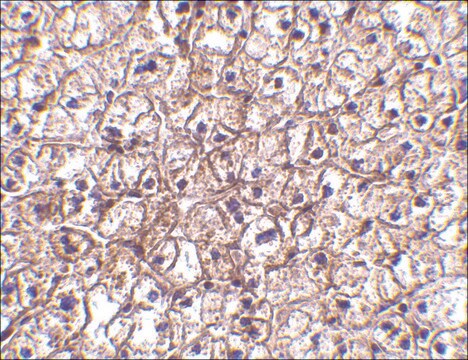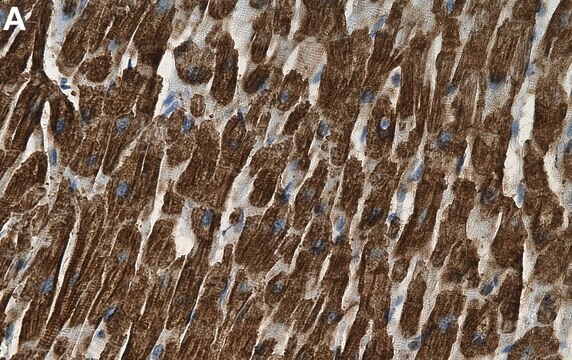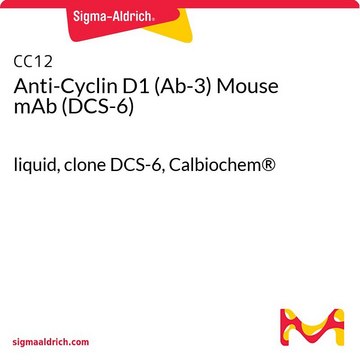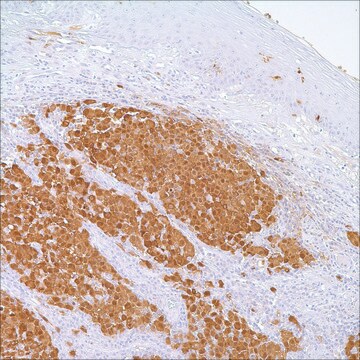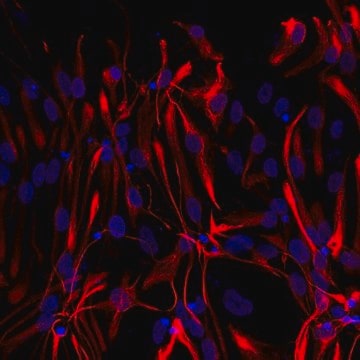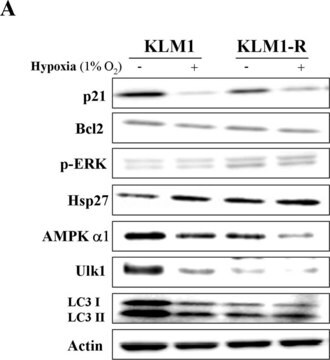MABF938
Anti-MxA, clone M143 (CL143)
clone CL143, from mouse
Sinónimos:
MxA, IFI-78K, Interferon-induced GTP-binding protein Mx1, Interferon-induced protein p78, Myxoma resistance protein 1, Myxovirus resistance 1, MX1
About This Item
Productos recomendados
biological source
mouse
Quality Level
antibody form
purified immunoglobulin
antibody product type
primary antibodies
clone
CL143, monoclonal
species reactivity
guinea pig, human, mouse, rat
technique(s)
flow cytometry: suitable
immunohistochemistry: suitable (paraffin)
western blot: suitable
isotype
IgGκ
NCBI accession no.
UniProt accession no.
shipped in
wet ice
target post-translational modification
unmodified
Gene Information
human ... MX1 (4599)
General description
Specificity
Immunogen
Application
Immunohistochemistry Analysis: Representative lots detected MxA immunoreactivity in patients-derived skin lesion samples using paraffin-embedded tissue sections (Urosevic, M., et al. (2007). J. Clin. Invest. 117(10): 2834–2846; Urosevic, M., et al. (2005). J. Natl. Cancer Inst. 97(15):1143-1153).
Flow Cytometry Analysis: A representative lot detected MxA expression in MxA-transfected U-87-H4 and U-87-D11, but not untransfected U-87-K4 human gliobastoma cells (Schneider-Schaulies, S., et al. (1994). J. Virol. 68(11):6910-6917).
Western Blotting Analysis: A representative lot detected a robust MxA induction in the lung tissue from guinea pigs that recieved intranasal administration of recombinant human alpha-IFN (Van Hoeven, N., et al. (2009). J. Virol. 83(7): 2851–2861).
Western Blotting Analysis: A representative lot detected a time-dependent MxA induction in the lung tissue from rats following intraperitoneal Seoul virus inoculation (Hannah, M.F., et al. (2008). Brain Behav Immun. 22(4):503-516).
Immunoprecipitation Analysis: A representative lot immunoprecipitated MxA from murine MxA-expressing Swiss 3T3 cells (clone 4.5.15) (Flohr, F., et al. (1999). FEBS Lett. 463(1-2):24-28).
Inflammation & Immunology
Immunoglobulins & Immunology
Quality
Western Blotting Analysis: 0.5 µg/mL of this antibody detected MxA in 10 µg of Swiss 3T3 (clone 4.5.15) cell lysate.
Target description
Physical form
Storage and Stability
Other Notes
Disclaimer
¿No encuentra el producto adecuado?
Pruebe nuestro Herramienta de selección de productos.
Storage Class
12 - Non Combustible Liquids
wgk_germany
WGK 1
flash_point_f
Not applicable
flash_point_c
Not applicable
Certificados de análisis (COA)
Busque Certificados de análisis (COA) introduciendo el número de lote del producto. Los números de lote se encuentran en la etiqueta del producto después de las palabras «Lot» o «Batch»
¿Ya tiene este producto?
Encuentre la documentación para los productos que ha comprado recientemente en la Biblioteca de documentos.
Nuestro equipo de científicos tiene experiencia en todas las áreas de investigación: Ciencias de la vida, Ciencia de los materiales, Síntesis química, Cromatografía, Analítica y muchas otras.
Póngase en contacto con el Servicio técnico
